News & Blogs
In this blog, we touch on diverse topics about Japanese food cultures, practices together with the culinary secret, TREHA®, and its important role in the Japanese food industry. We hope our blog helps you obtain in-depth knowledge of the secrets and science behind Japanese cuisine, shared from our kitchen, to yours.
The Taste of Spring
In Japanese cuisine, the saying "Add bitterness to the spring plate, " emphasizes incorporating mountain vegetables as a seasonal flavor. Spring mountain vegetables, or sansai 山菜, offer a delightful array of flavors, colors, and textures, representing the eagerly anticipated arrival of spring. Fuki-no-tou フキノトウ (Butterbur sprouts) and tara-no-me タラの芽 (Aralia elata shoots) are best enjoyed tempura-style. Udo 独活 (mountain asparagus) is delicious as kinpira (a cooking technique for sautéed and simmered vegetable). Meanwhile, tsukushi 土筆 (horsetail shoots) and warabi 蕨 (braken) are perfect for simmered dishes. Bracing the brief season when these seasonal delicacies are available is a joy shared by many including myself.
Spring mountain vegetables are a precious delicacy that can only be enjoyed briefly. However, some people may find it challenging to eat due to their astringent bitterness. I used to dislike this bitterness as a child and wondered why anyone would willingly eat such things. However, I gradually came to appreciate and even enjoy it as I grew up. Now, I eagerly anticipate this fleeting seasonal delicacy every spring.
In this article, I would like to introduce the essence of savoring spring mountain vegetables and the ingenuity that has been cultivated to enjoy them.
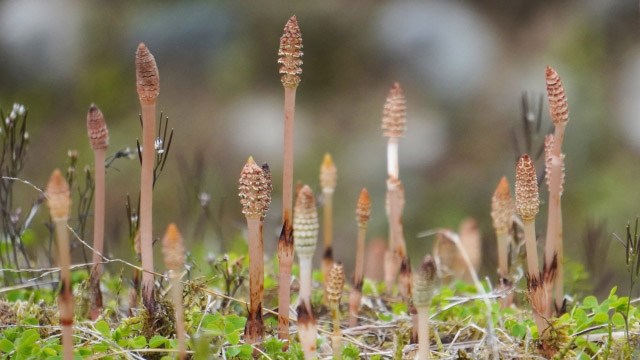
Poisons That Are Good for You!?
The unique bitterness of mountain vegetables is a protective compound naturally produced by plants to deter insects and animals. During the harsh cold of winter, plants sprout small buds, and as spring brings warmth, they rapidly grow. Similarly, as spring approaches, insects and animals become more active with hearty appetites. This bitterness serves as a defense mechanism for plants, ensuring that their tender and vital new shoots are not consumed by predators, thereby allowing their growth unhindered. The compounds responsible for bitterness vary widely by plant. It's fascinating how we, as humans, can discern and appreciate the nuances of this bitterness, finding deliciousness within it. Bitter foods like coffee, chocolate, and beer are beloved worldwide for their distinct bitterness, showcasing how such flavors are cherished in culinary delights.
Why do humans desire such diverse "bitterness" in the first place? Humans can discern "bitterness" primarily because their tongue receptors are exceptionally developed. The number of taste buds related to bitterness on the human tongue is significantly higher compared to those for sweetness or umami. This ability has evolved over time to enable humans to easily detect toxins in food. Since bitter-tasting foods are often associated with toxicity, this instinct evolved to prevent further consumption. On the other hand, the compounds responsible for bitterness include various polyphenols and alkaloids, some of which possess strong antioxidant properties. While these compounds may be toxic to small animals, they are beneficial for larger human bodies, helping to cleanse the system after the winter months. Throughout human culinary history, the bitterness of spring mountain vegetables can be seen as one of the acquired tastes, gained through knowledge such as "a small amount of poison can also be medicinal."
“A small amount” is the key here because consuming large amounts of these compounds at once can be excessively bitter and not palatable, potentially causing unexpected discomfort. That's why certain types of mountain vegetables require a pre-treatment process called "aku-nuki あく抜き," which removes bitterness, ensuring they are suitable for consumption to prevent any adverse health effects.
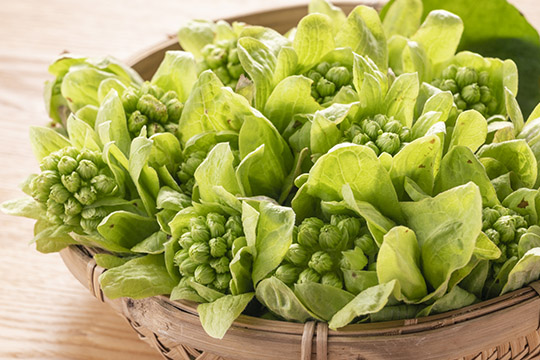
Rewarding Hardwork to Remove Bitterness
Warabi, zenmai, and takenoko (bracken fern, royal fern, and bamboo shoots, respectively), which tend to have a slightly strong bitterness if consumed raw. To remove bitterness, they require a pre-boiling process in an alkaline solution prepared with the addition of baking soda. Bamboo shoots are more challenging than others. Despite developing tough cylindrical outer skins as they mature, bamboo sprouts are unexpectedly pleasant when they're young. These delicate baby bamboo shoots can be harvested for only about 10 days because they grow rapidly into sturdy bamboo after emerging above ground. The tiny tips of these delicate, precious shoots dormant in the ground must be carefully located and unearthed using a keen sense of the toes. Then, the core part, after carefully peeling off several layers of tough skin, needs to be pre-boiled in a solution with plenty of rice bran. Depending on the size, the boiling process can take over three hours, requiring careful attention to prevent overflow.
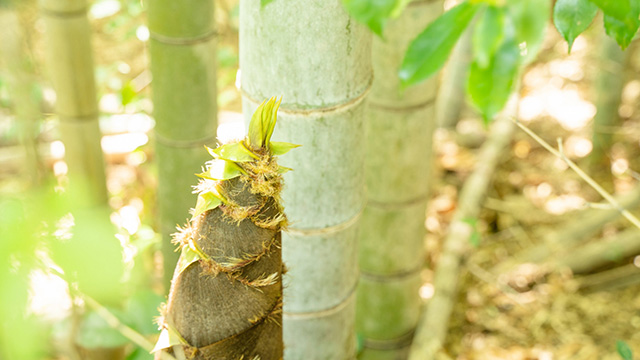
After painstaking efforts of removing the bitterness, bamboo shoots feature the unique flavor and crunchy texture, which can be utilized in various cooking styles and cuisines such as Japanese, Western, or Chinese.
Upcycling rice bran:
To remove bitterness of spring mountain vegetables like bamboo shoots, it's necessary to boil them in water with an alkaline pH, which facilitates the extraction of the components responsible for the bitterness. Rice bran, the outer layer of the rice kernels and often discarded after rice polishing, plays a crucial role here. When dissolved in water, rice bran exhibits alkaline properties, making it the most convenient material to pre-treat mountain vegetables. This method showcases the resourcefulness of utilizing rice, a staple food for Japanese people, and can be considered part of long-evolved culinary wisdom in Japan.
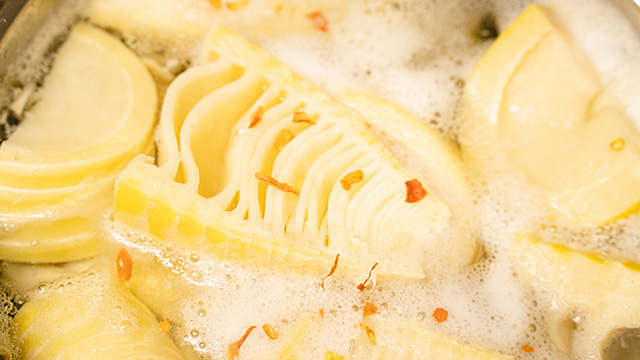
Tempura, my favorite:
To savor spring mountain vegetables, tempura is the most convenient cooking method. Please read our past blog post talking about tempura. Deep frying method effectively removes bitterness to a suitable degree, making it convenient for preparing mountain vegetables. Personally, tempura is my favorite. It optimizes the unique textures (the crispness of leafy greens or the crunchiness of bamboo shoots) and aroma specific to each vegetable.
How to prepare tempura with TREHA®?Please try this recipe.
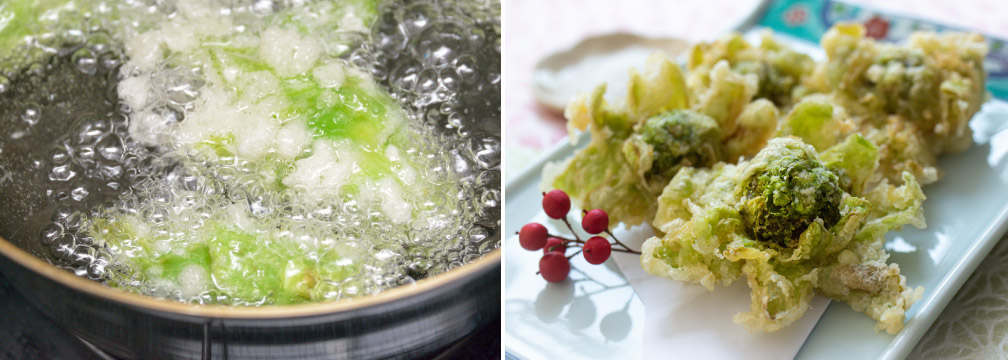
Asparagus, Symbol of Spring in Western Cuisine
In the West, asparagus may be considered a vital vegetable heralding the arrival of spring. When spring comes, asparagus shoots emerge from the ground and grow rapidly. Whether green or white, asparagus tends to have a slight bitterness. This bitterness comes from a compound called "saponin," also abundant in soybeans. "Saponin" is a well-known polyphenol with various medicinal properties, including antioxidants, immunity booster, and obesity prevention. It may assist in efficiently getting rid of accumulated fats and waste from the body, accumulated during the winter months.
It is such a pleasure to bite a deep-fried whole asparagus, tasting slight bitterness and crisp texture, which indeed the best tempura could offer!

Did you find this blog interesting?
Please share it with your friends in the food service industry.
We regularly update the blog about the food culture of Japan, where TREHA® was discovered for culinary applications.
Click here and send us a message to subscribe.
Or hit us up on Instagram @trehalose_sensei!
You might also be interested in:
Cooking and baking with TREHA®: Japanese cuisine
Dashi soup stock – the foundation of Japanese cuisine (Read the article)
Exploring the World of Onigiri from Traditional Snacks to Global Delights (Read the article)
Black garlic – Unique and irresistible new flavor (Read the article)


